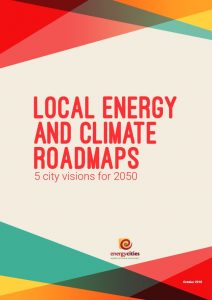Rethinking urban lifestyles to transform San Sebastián into a carbon-neutral city in 2050
The Basque city of San Sebastián (Spanish), home to about 186,000 inhabitants, is the administrative capital of the province of Guipúzcoa and a major culture and tourist hub in Northern Spain. As a coastal city, San Sebastián and its people, nicknamed the Donostiarras, are aware that they are on the frontline of climate change and therefore have to strengthen their resilience and take ambitious climate and energy action. In June 2018, the city has adopted its long-term roadmap “Plan de Acción Klima 2050 de Donostia / San Sebastián”, which reflects a clear commitment to tackle climate change, catalyse the clean energy transformation and maintain an urban environment that makes responsible use of our planet’s resources.
San Sebastián’s 2050 roadmap, the “Plan de Acción Klima 2050 de Donostia / San Sebastián”, was developed in 2017 and adopted by the city in 2018. Its trajectory of emissions for 2030 and 2050 is based on the 2050 Climate Change Strategy of the entire Basque Autonomous Community. San Sebastián followed an integrated approach in the development of its roadmap. Firstly, five strategic areas of action were identified:
1. Information, i.e. the way citizens get to know and share information about climate issues,
2. Lifestyles, i.e. the relationship between citizens’ actions and GHG emissions,
3. Structures, i.e. the way citizens experience the city´s physical (e.g. infrastructure like buildings) character,
4. Technology, i.e. the way citizens apply knowledge gained through e.g. smart applications to reduce their emissions and finally,
5. Norms, i.e. the way citizens adjust to and support each other within their social relations. Those five strategic areas of action (see picture below) were then applied to four different sectors: Energy, Circular Economy, Land Use and Mobility. This exercise within the city’s roadmap resulted in a diverse set of actions that will enable San Sebastián to reach carbon neutrality by 2050.
Overall Energy & Transport goals by 2050
- To become carbon neutral by reducing CO2 emissions by at least 80% compared to 2007
- Zero emissions in transport
- Zero waste
- Widespread adoption of circular economy
Objectives
- Reduce land use by limiting the artificial occupation of more territory
- Decarbonise the energy sector
- Produce and consume goods based on principles of circular economy
- Sustainable maintenance, construction and usage of infrastructures and buildings.
Targets
- 80% of buildings with high energy efficiency
- Minimum of 80% share of renewable energy in final energy consumption
- Electrification of private and public transport
Decarbonise the energy sector and eliminate energy poverty
The roadmap aims at decarbonising the energy sector by shifting to renewables, while at the same time increasing energy efficiency. In addition, energy poverty should be eradicated in San Sebastián
- Min. 80% reduction of GHG emissions by increasing renewables & energy efficiency
- Min. 80% share of renewable energy in final energy consumption by 2050.
HOW
- Implement programmes for energy savings and improve energy efficiency measures for a) industrial and tertiary activity, b) events, c) domestic housing, including air conditioning, hot water and lighting that will stimulate decarbonisation.
- Implement advisory programme to support companies in their decarbonisation activities and energy savings.
- Guarantee that energy supply of all facilities and properties belonging to the municipality is based on renewable sources.
- Develop an elaborated investment programme and management plan for the generation of energy from renewable sources in municipal facilities.
- Develop a communication programme that encourages the installation of private facilities that generate energy from renewable sources.
- Establish a municipal energy service company that not only generates, distributes and promotes energy from renewable sources, but moreover is self-consuming and promotes energy efficiency and energy saving measures.
- Approve new regulation on municipal energy efficiency and environmental quality of buildings based on climate criteria.
- Implement rehabilitation programmes and regeneration of buildings based on energy efficiency and decarbonized sources
- Implement support programme for financing and taxing energy and social rehabilitation of the dwellings based on energy efficiency and decarbonisation standards
- Improve energy efficiency standards for trade, services and restoration and include these, where appropriate, in the plans of the climate activity centres (e.g. companies, universities, hospitals, etc.).
- Establish an aid programme for those suffering from energy poverty.
Zero Emissions in Mobility Sector
San Sebastián wants to achieve zero emissions for its mobility sector by 2050. Therefore, motorized transport (especially individual car trips) need to be greatly reduced, and private and public transport substantially cleaned and electrified.
MEASURES and TARGET
- 60% of all motorized journeys within the city covered by public transport by 2030
- 20% reduction of the trips made by private motorized transport by 2030
- Electrification of the entire bus fleet by 2030
HOW
- Align mobility plans of activity centres (e.g. companies, universities, hospitals, etc.)
- Develop a school road programme based on sustainable mobility principles.
- Introduce speed limits of 30 km/h throughout the city (20km/h in high density areas).
- Improve cycling and walking infrastructure
- Develop further the Donostialdea metro service
- Ban diesel cars from the city starting in 2020
- Gradually replace delivery vehicles with low- emission vehicles or non-motorized vehicles.
- Create zero emission zones without cars in the city and limit parking spaces in public areas
- Develop widespread electric charging infrastructure for public and private transport
Governance
In San Sebastián, several existing policies are already aligned to the objectives of the roadmap. However, there are also 19 different plans coexisting within the municipal administration that are currently operating outside of the roadmap’s scope. Therefore, a redefinition of the city’s governance architecture is required, so that each administrative body links the roadmap to the plan it is ultimately responsible for. The development of San Sebastián’s roadmap provided the perfect occasion to face this transformation towards a new administrative culture. In the roadmap, policies and measures have been allocated equally among different municipal departments through the principle of transversality. Consequently, various new channels of communication, cooperation and management structures have emerged, thereby changing the governance of the city administration. However, implementing this new administrative culture of transversality within the city administration requires presently inflexible structures and methods of working to become more flexible and thereby efficient. In order for San Sebastián’s roadmap to succeed, every municipal department will from now on be obliged to incorporate climate and energy objectives into its own plan, and also the roadmap actions it is responsible for. Such an integrated approach exemplifies how climate mainstreaming can be introduced into the everyday working culture of the city administration.
Furthermore, a set of different governance bodies are responsible for the implementation of San Sebastian’s roadmap. The city´s climate coordination board, Klima DSS 2050, represents the plan´s political-technical management body and is responsible for encouraging and facilitating all departments to align their sectoral policies for achieving the climate commitments. Led by the mayor´s office, the board will supervise, evaluate and promote the implementation of the plan´s measures and respective climate policies. Finally, its task is to ensure that climate actions of the different organs, such as sectoral councils and the social council, will be complementary. The DSS 2050´s technical commission will ensure that the councillors responsible for ecology, finance, mobility, sustainable urbanism, presidency, as well as the promotion of citizen participation and the office of strategic planning and the Cristina Enea Foundation (a key environmental stakeholder in the city) are on board.
Citizen Participation
Public participation in San Sebastián’s roadmap goes beyond the understanding of public participation as an open debate or discussion. Instead, it includes commitment and intervention of all local stakeholders and citizen in decision-making processes, as well as in the development of policies and measures. Furthermore, citizen engagement in the Basque city also involves the stimulation of citizen initiatives and the establishment of possible public-private partnerships.
Consequently, the development and implementation of San Sebastián’s roadmap is about designing new forms of collaborative governance within the city by mobilising the collective intelligence of its inhabitants. The city thereby encourages active and informed citizenship, thus enhancing democratic values, reinforcing the concept of people power, while at the same time strengthening transparency, distribution of responsibilities and accountability.
“The city of the future needs people like those who have made the city of the present a reality. Citizens who are responsible, active and trained to achieve global, changing evolution, which is only possible by means of strong values and social capital. Citizens who cooperate, who organise themselves, who lead the way in a life without violence and projects and who open the way to permanent, sustainable development.”


